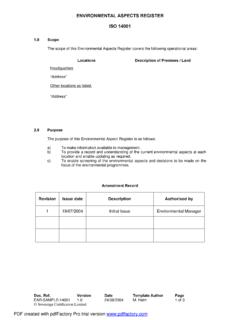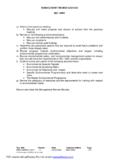Transcription of REGISTER OF LEGISLATION ISO 14001 - Sovereign Certification
1 REGISTER OF LEGISLATION ISO 14001 Doc. Ref. Version Date Template Author Page ROL-SAMPLE- 14001 24/08/2004 Mark Helm 1 of 10 Sovereign Certification Limited Scope The scope of this REGISTER of LEGISLATION covers all our organisational areas: Locations Description of Business Headquarters Address Other locations as listed: Address Purpose The purpose of this REGISTER of LEGISLATION is as follows: a) To make information available to management. b) To provide a record and understanding of the current LEGISLATION applicable at each location and enable updating as required. c) To enable actions and decisions to be made the environmental management of the organisation. Amendment Record Revision Issue date Description Authorised by 1 19/07/2004 Initial Issue Environmental Manager PDF created with pdfFactory Pro trial version OF LEGISLATION ISO 14001 Doc. Ref. Version Date Template Author Page ROL-SAMPLE- 14001 24/08/2004 Mark Helm 2 of 10 Sovereign Certification Limited NOTE: THIS DOCUMENT IS AN EXAMPLE ONLY OF THE TYPE OF DOCUMENT THAT COULD BE PRODUCED AND WILL BE DEPENDANT UPON THE COMPLEXITY OF THE ORGANISATION AND THE TYPE OF WORK THAT IT IS INVOLVED IN.
2 THIS DOCUMENT IS NEITHER CURRENT OR ACCURATE FOR A SPECIFIC ORGANISATION AND IS ONLY INTENDED TO GIVE AN IMPRESSION OF THE POTENTIAL FOR A REGISTER OF LEGISLATION . Contents 1. Emissions to Air 2. Noise 3. Liquid waste / Emissions to Water 4. Solid Waste & Packaging Materials 5. Land Contamination 6. Energy 7. IPPC Integrated Pollution Prevention & control 8. Miscellaneous LEGISLATION PDF created with pdfFactory Pro trial version OF LEGISLATION ISO 14001 Doc. Ref. Version Date Template Author Page ROL-SAMPLE- 14001 24/08/2004 Mark Helm 3 of 10 Sovereign Certification Limited 1. Emissions to Air The manufacture of chemicals will involve varied emissions to air many of which could have a significant environmental impact unless carefully controlled and/or treated. For the Chemicals manufacturing industry, much of the legislative control will be enacted through the Pollution Prevention and Control (England and Wales) Regulations 2000 (PPC 2000) for Part B processes (See section 7 IPPC).
3 Certain prescribed industrial processes and businesses require an authorisation from the environmental regulator (local authorities in England and Wales) before they can lawfully operate. These processes are listed in the Environmental Protection (Prescribed Processes and Substances) Regulations 1991 which assesses each case based on different categories of process, essentially on the basis of their likely environmental impact. Less polluting processes are regulated only in respect of their emissions to air. This system is being phased out according to according to a transitional timetable set out in Schedule 3 of PPC 2000. Schedule 1 of PPC 2000 lists those prescribed processes requiring a permit to operate. Environmental Protection Act (EPA) 1990, Part III (Statutory Nuisance) Dust, steam, odour or other effluvia emitted from industrial, trade or business premises that are prejudicial to health are defined as Statutory nuisances under of this Act.
4 Subject to Local Authority Abatement Notices. Breach of notice or order is a criminal offence. Clean Air Act 1993 Relating to Smoke, grit, dust or fumes emitted from a premises. The main provisions of the Act co-exist with the Statutory Nuisance provisions of the EPA 1990. Environment Act 1995, part IV Which makes provisions for the NAQS (national air quality strategy) The NAQS is enforced by local authorities and include the following regulations: Air Quality Standards (Amendment) Regulations 1995 (SI 1995 No. 2146) Air Quality Regulations 1997 (SI 1997 No. 3043) Air Quality Limit Values Regulations 2003 Environmental Protection Act (EPA) 1990, Part I, part B (less polluting substances) (IPPC) EC Directive 96/61//EC on Integrated Pollution Prevention and Control, enacted in the UK by the Pollution Prevention and Control Act 1999, that is implemented by the Pollution Prevention and Control Regulations 2000 (England & Wales) (PPC) Subject to Local Air pollution control (LAPC) that is currently being extended and replaced by the European Integrated Pollution Prevention and Control Directive (IPPC) (see section 7 IPPC).
5 Environmental Protection (Prescribed Processes and Substances) Regulations 1991 Listing prescribed industrial processes and businesses that will require an authorisation from the environmental regulator before they can lawfully operate. The Environmental Protection (Controls on Substances that Deplete the Ozone Layer) Regulations 1996 This LEGISLATION applies controls on the use, production, importation and exportation, placing on the market, recovery, recycling and destruction of substances that have an adverse impact on the ozone layer in the upper atmosphere. These regulations are likely to apply if you use or handle refrigeration, air conditioning or dry cleaning equipment, insulating foam, industrial solvents or halon fire-extinguishing systems. The Solvent Emissions (England and Wales) Regulations 2004 Made under section 2 of the Pollution Prevention and Control Act 1999 and concerning the limitation of emissions of volatile organic compounds due to the use of organic solvents in certain activities and installations.
6 This LEGISLATION implements provisions of European Council Directive 1999/13/EC. The Directive requires all installations carrying out activities listed in Annex I of the Directive above the thresholds in Annex IIA of the Directive to comply with certain emission limit values. PDF created with pdfFactory Pro trial version OF LEGISLATION ISO 14001 Doc. Ref. Version Date Template Author Page ROL-SAMPLE- 14001 24/08/2004 Mark Helm 4 of 10 Sovereign Certification Limited Emissions to Air summary Key LEGISLATION for industrial processes: Environmental Protection Act (EPA) 1990 Clean Air Act 1993 The Environmental Protection (Controls on Substances that Deplete the Ozone Layer) Regulations 1996 The Solvent Emissions (England and Wales) Regulations 2004 Environmental Protection (Prescribed Processes and Substances) Regulations 1991 Pollution Prevention and Control Regulations 2000 (England & Wales) Key LEGISLATION for ambient air quality: Environment Act 1995 Air Quality Regulations 1997 2.
7 Noise For environmental purposes, noise is defined as unwanted sound . Noise is considered a nuisance in common law and a statutory nuisance if it is prejudicial to health or unreasonably interferes with an individuals rights or enjoyment of their property. Assessment of noise levels is based on methods described in BS 4142. Environmental Protection Act (EPA) 1990 The EPA 1990 gives an aggrieved individual the right to take action through a magistrate s court for statutory noise nuisance. Defence against such a claim can include the use of best available techniques (BAT) to prevent or control the noise or that the operations were conducted in accordance with its consent. Health and Safety at Work Regulations 1974 effected by the Noise at work Regulations 1989, which implement the requirements of EC Directive 86/188/EEC on the protection of workers from the risks related to exposure to noise at work. See HSE Noise at Work Guides 1 to 8.
8 The Supply of Machinery (Safety) Regulations 1992 implementing the requirements of EC Directive 89/392/EEC providing for the harmonisation of basic safety requirements for machinery produced within the EU and including noise. Noise Summary Key LEGISLATION for Noise Environmental Protection Act (EPA) 1990 Health and Safety at Work Regulations 1974 Noise at work Regulations 1989 The Supply of Machinery (Safety) Regulations 1992 PDF created with pdfFactory Pro trial version OF LEGISLATION ISO 14001 Doc. Ref. Version Date Template Author Page ROL-SAMPLE- 14001 24/08/2004 Mark Helm 5 of 10 Sovereign Certification Limited 3. Liquid waste / Emissions to Water Due to the highly polluting nature of many of the raw materials used by the chemicals Industry, PPC 2000 requires that any company carrying out processes listed under Processes subject to IPPC or LAPPC (see section 7 IPPC) apply for a permit to carry out those processes and have management systems in place to minimise the potential environmental impacts.
9 The LEGISLATION listed below will be relevant should the company produce liquid wastes that are disposed of offsite, stored onsite, transported by the company, released to natural water courses or to foul sewers or if the company takes delivery of or stores/dispatches liquid wastes that could find their way into the ground, drains or water courses if handled or stored incorrectly. Discharges to sewer are covered by trade effluent consents issued by Local Authorities, while discharges to surface waters are regulated by the Environment Agency. Environmental Protection (Prescribed Processes and Substances) Regulations 1991 Containing Schedule 5 that lists the 23 substances that are particularly hazardous to the aquatic environment. The same substances plus two others are listed in the Trade Effluents (Prescribed Processes and Substances) Regulations 1989. The Environment Agency is involved in any application for consent to discharge such substances whether to sewers or controlled waters as a trade effluent.
10 Water Resources Act 1991 Making it an offence to knowingly permit , or through lack of action cause the pollution of controlled waters surface water gullies, watercourses and ground water. Water Resources Act 1991 Making it an offence to cause or knowingly permit any matter other than trade effluent to enter controlled water by discharge from a drain or sewer. Water Resources Act 1991 as amended by the Environment Act 1995 Empowering the Environment Agency to serve works notices where it appears to the agency that any poisonous, noxious or polluting matter or any solid waste matter is likely to enter or be present in any controlled waters. This may include the provision of a bund wall around above ground storage tanks even though no pollution has yet been caused. Water Resources Act 1991 as amended by the Environment Act 1995 Empowering the Environment Agency to carry out any works or operations to prevent the pollution of controlled waters or restore such waters after pollution.













